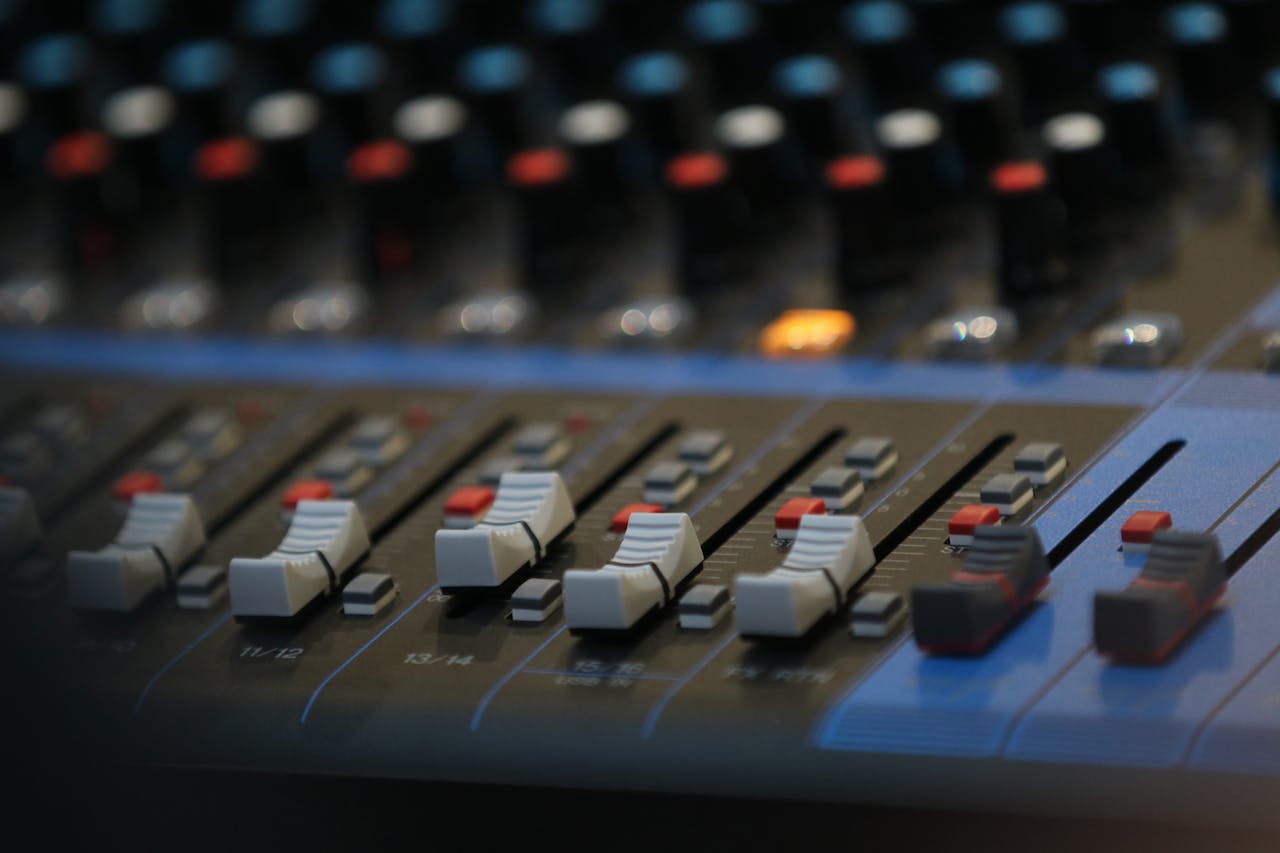In the world of audio recording and podcast production, the quality of your equipment can make or break your sound. Whether you’re a budding musician, a seasoned producer, or somewhere in between, having a reliable USB interface is crucial.
But with so many options on the market, how do you choose the best one? Today, we’ll be diving deep into the top 8-channel audio interfaces, examining their panel features, pros, and cons to help you make an informed decision.
Related: Best Podcast Mixers
Contents
The Best 8 Channel Audio Interfaces
Following are the top-notch 8-channel audio interfaces of all time.
1. Apollo x8
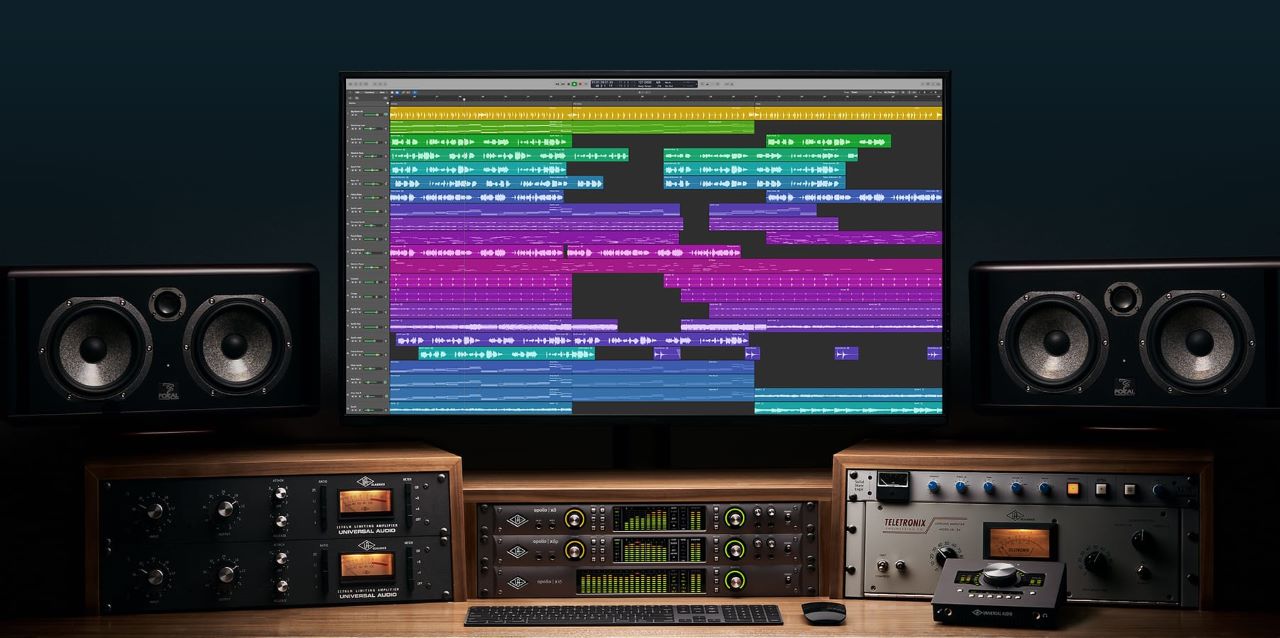
The Apollo x8 has 4 Unison-enabled mic/line preamps — giving you fully authentic preamp emulations from Neve, API, Manley, Avalon, and more. Image Source.
Key Features
- Elite-class A/D and D/A conversion
- Four onboard Unison™ preamps for real-time tracking
- HEXA Core UAD plug-in processing
- Seamless hardware-software integration with LUNA Recording System
- Ability to link up to four Apollos for 160 channels of premium I/O
The Apollo x8 is not just an audio interface; it’s a gateway to a world of professional analog tones that have graced countless records. Designed for both larger projects and bedroom studios, this sleek rackmount Thunderbolt 3 audio interface boasts elite-class conversion and HEXA Core UAD plug-in processing. This means you can record in real time through iconic preamps from brands like Neve, API, Manley, and more, all with near-zero latency.
The Apollo x8 promises the widest dynamic range and lowest noise available, ensuring that every detail in your recordings shines through. Its A/D and D/A conversion is renowned for its open and natural sonics, providing the perfect canvas for your audio masterpiece.
Moreover, with its four onboard Unison™ preamps, you can track in real-time through various preamps and channel strips, capturing the rich analog texture that has defined music for decades.
Pros
- Professional sound quality with near-zero latency
- Wide range of preamp emulations available
- Seamless integration with major DAWs and LUNA Recording System
- Expandable as your studio grows
Cons
- Might be overkill for hobbyists or those on a tight budget
- Requires a Thunderbolt 3 connection
2. RME Fireface UCX II
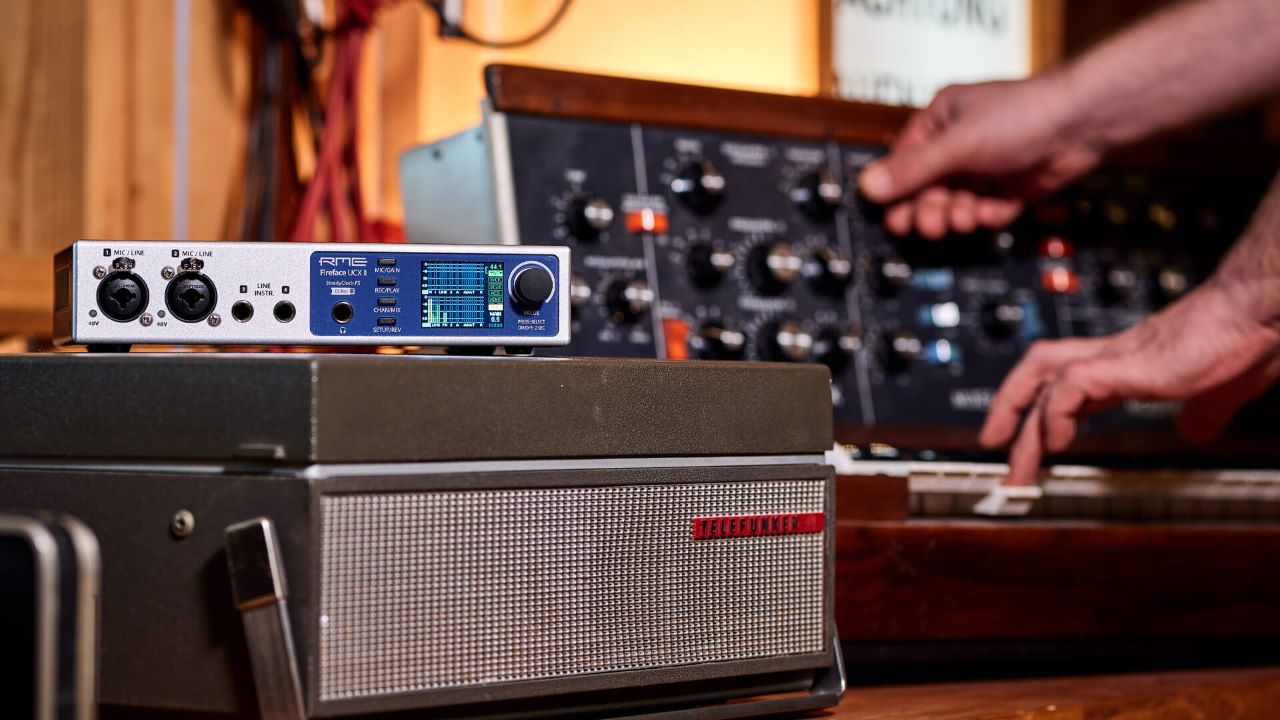
All inputs or outputs of the Fireface UCX II can be recorded directly to a USB storage device. Image Source.
Key Features
- 40-channel advanced USB audio interface
- Digital connections: 1 x AES I/O, 1 x ADAT I/O, 1 x SPDIF I/O Coax, 1 x Word Clock I/O, 1 x MIDI I/O
- SteadyClock FS for superior jitter rejection
- DURec: Integrated digital recorder for all inputs and outputs
- TotalMix FX DSP mixer for comprehensive routing and monitoring
- DC-coupled outputs for CV/Gate voltage control with modular synthesizers
- Class Compliant mode for native OS support
The RME Fireface UCX II is a testament to RME’s dedication to compact, high-quality audio interfaces. This 40-channel advanced USB audio interface is designed for both studio and live recordings, fitting a plethora of features into a half-rack size unit that would typically require multiple 19-inch panels. The Fireface UCX II is not just about compactness; it’s about delivering top-tier audio quality and versatility.
The interface boasts a range of connectivity options, from analog I/Os to digital connections like ADAT and SPDIF. On the front panel, you’ll find two mic/line preamps in an XLR combo configuration, two digitally controlled line/instrument inputs, and a headphone jack.
The rear houses ten analog balanced line inputs and outputs, MIDI I/O, ADAT I/O, AES/EBU and SPDIF I/O, and a USB 2.0 port. One of the standout features is the SteadyClock FS, RME’s latest clock and jitter rejection technology. Based on a femtosecond clock, it ensures the lowest possible jitter, enhancing the quality of your recordings.
Pros
- Compact design with a wide range of connectivity options
- Superior jitter rejection with SteadyClock FS
- Integrated digital recorder allows for stand-alone recording
- Comprehensive routing and monitoring with TotalMix FX
- DC-coupled outputs ideal for modular synthesizer enthusiasts
Cons
- Might be overwhelming for beginners due to its extensive features
- USB 2.0 might be considered dated for some users
3. Focusrite Clarett+ 8Pre
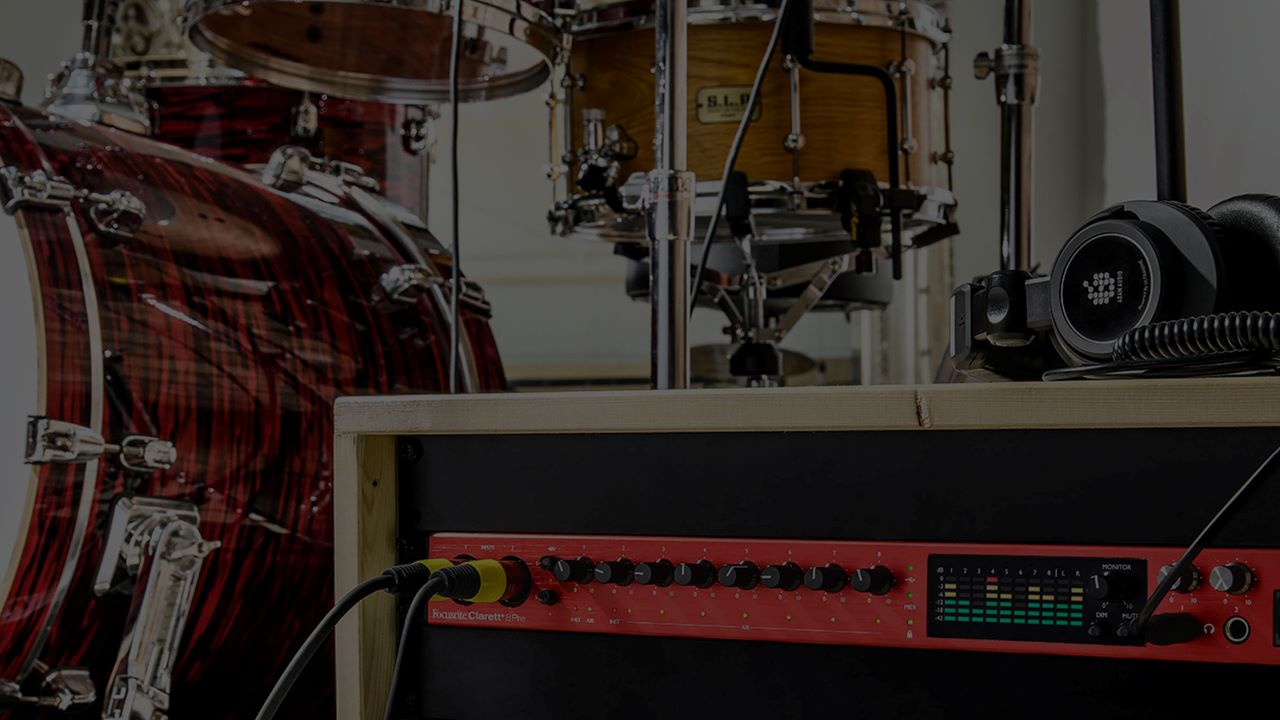
The Clarett+ 8Pre has all-analogue Air mode, with impedance switching, adds presence and clarity to your recordings, recreating the legendary character of the ISA. Image Source.
Key Features
- With two Hi-Z JFET gadget inputs it offers 8 Clarett mic pres
- All-analog Air mode with impedance switching, recreating the legendary character of the ISA
- Low distortion, 24-bit/192 kHz converters with up to 124dB dynamic range
- Two powerful, flat-response headphone outputs
- USB-C connectivity, compatible with MacOS, Windows, and iPad
- Includes Ableton Live Lite, three months of Pro Tools Artist, and the Hitmaker Expansion with plugins from renowned brands
- Eight inputs, ten outputs; eight-in, eight-out over ADAT
The Focusrite Clarett+ 8Pre is a studio-grade audio interface tailored for the established producer. This interface is designed to bring pure analog sound to your studio, ensuring that every recording is of the highest quality. The Clarett+ 8Pre boasts eight meticulously engineered Clarett preamps that aim to deliver authentic large-format studio sound to any recording session.
With the all-analog Air mode and impedance switching, it recreates the illustrious effect of Focusrite’s ISA mic pres, adding transparency and presence to various instruments, from drums to vocals.
One of the standout features of the Clarett+ 8Pre is its pair of high-impedance JFET inputs. These inputs are designed to preserve the true character and feel of your guitar, mimicking the sensation of plugging directly into an amplifier. The interface also offers independent A-D and D-A converters, ensuring ultra-low distortion and a dynamic range of up to 124 dB.
This means that every detail of your recording will be captured with incredible clarity. Furthermore, the Clarett+ 8Pre is equipped with ten balanced outputs, ensuring hum-free monitoring, mixing, and mastering.
Pros
- High-quality preamps for authentic studio sound
- Versatile connectivity options for various instruments and devices
- Comprehensive software bundle for recording, mixing, and mastering
- Expandable via ADAT for larger setups
Cons
- Might be on the pricier side for beginners
- Requires a USB-C connection, which might not be available on all devices
4. Focusrite Scarlett 18i20 [3rd Gen]
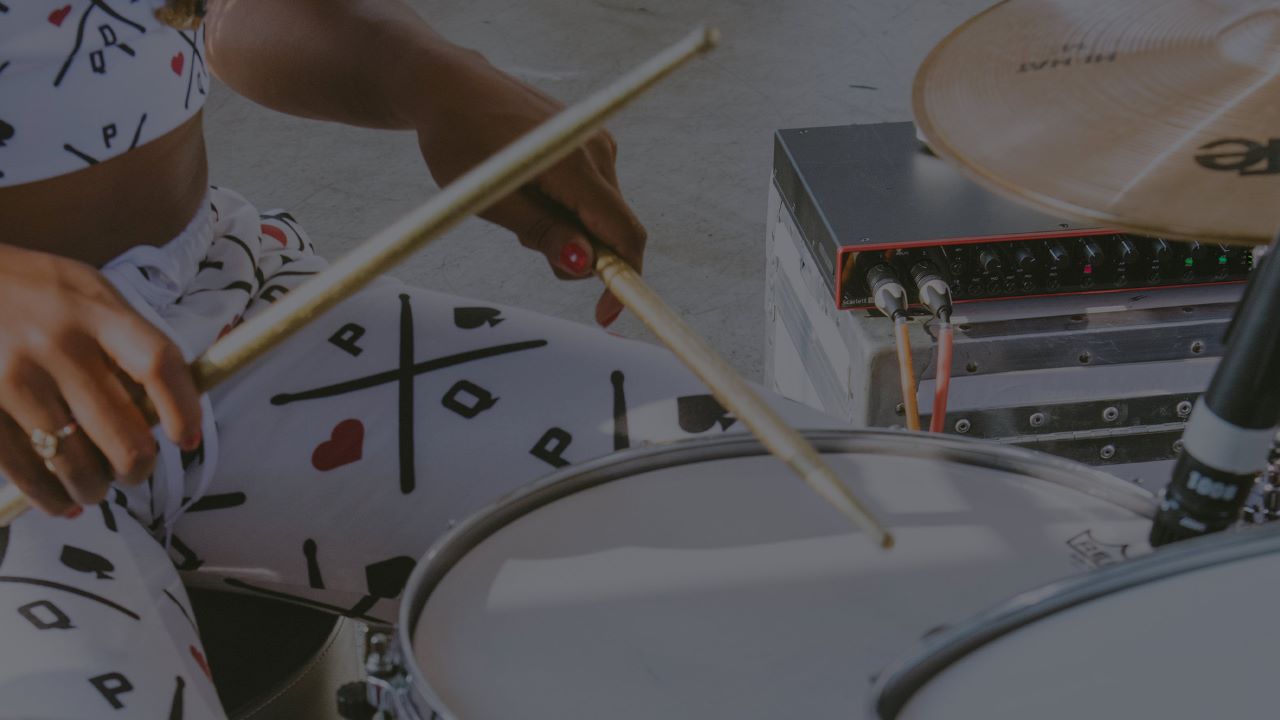
The 18i20’s 24-bit/192 kHz converters deliver studio-quality sound. Image Source.
Key Features
- Eight 3rd Generation Scarlett microphone preamps with Air mode
- 18 inputs and 20 outputs for extensive simultaneous I/O
- Two Hi-Z instrument inputs and ten balanced outputs
- 24-bit/192 kHz converters for studio-quality sound
- Built-in talkback mic and speaker switching
- Loopback functionality for streaming and sampling
- USB-C connectivity, compatible with MacOS and Windows
- Comes with Ableton Live Lite, Avid Pro Tools Artist, and the Hitmaker Expansion
The Focusrite Scarlett 18i20 [3rd Gen] is a powerhouse of an audio interface designed to be the heart of your studio setup. With its high channel count and professional-grade audio quality, it’s equipped to handle even the most demanding recording sessions.
The 18i20 offers a whopping 18 inputs and 20 outputs, ensuring that you have all the connectivity you need to record a full band straight out of the box. The eight 3rd-generation Scarlett mic preamps are a testament to Focusrite’s commitment to sound quality, delivering pristine audio that captures every nuance of your performance.
The Air mode, a feature that emulates the great outcome of Focusrite’s ISA mic pres, adds a touch of brilliance to vocals and guitars, making them stand out in the mix. For guitarists, the high-headroom, high-impedance instrument inputs ensure that your guitar’s signal is captured without any unwanted clipping.
The 18i20 also boasts ten balanced outputs with anti-thump speaker switching, providing hum-free monitoring that’s perfect for mixing and mastering. The built-in talkback mic is a handy feature for producers, allowing easy communication with artists during recording sessions.
With its comprehensive software bundle, including Ableton Live Lite, Avid Pro Tools Artist, and the Hitmaker Expansion, the 18i20 is a complete recording solution for professionals and enthusiasts alike.
Pros
- High channel count suitable for recording full bands
- Superior sound quality with 3rd Generation Scarlett mic preamps
- Comprehensive software bundle for a complete recording solution
- Built-in talkback mic for easy communication during sessions
Cons
- Might be overkill for solo artists or small setups
- Higher price point compared to other interfaces in the Scarlett range
5. PreSonus Studio 1824c
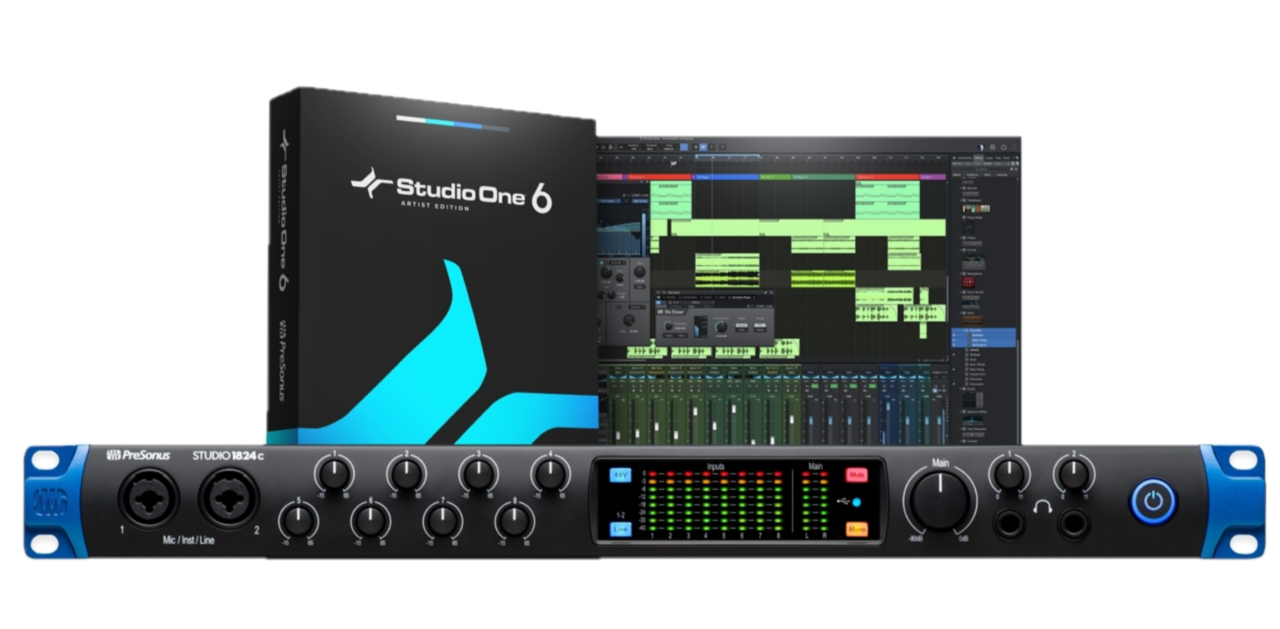
The Studio 1824c has USB-C to USB-C and USB-C to USB-A cables included for compatibility with most computers. Image Source.
Key Features
- With 4 channels at 96 kHz, 8 channels of ADAT Optical I/O
- 20 outputs and 18 inputs simultaneously (8×8 at 192 kHz)
- XMAX Class A mic preamps with 2 mic/instrument/line inputs
- XMAX Class A mic preamps with 6 mic/line inputs
- With individual-level controls it offers two stereo headphone outputs
- 18×8 onboard DSP monitor mixer
- 8 equal ¼-inch TRS line outputs and 2 balanced ¼-inch TRS main outputs
- USB-C connectivity with included USB-C to USB-A cables and USB-C to USB-C
- Comes with Studio One Artist®, Studio Magic Software Suite, and Ableton® Live Lite
The PreSonus Studio 1824c is a testament to PreSonus’ two-decade-long legacy in creating high-channel-count audio interfaces. Designed for recording extensive sessions, the Studio 1824c is a culmination of pristine sound quality and versatile functionality.
It boasts eight of PreSonus’ renowned XMAX analog mic preamps, ensuring that every recording is captured with the utmost clarity and depth. With a 24-bit 192 kHz conversion, the interface guarantees that every nuance of your performance is preserved in the digital realm.
The Studio 1824c is not just about quantity but also quality. The XMAX mic preamps are famous for recording complex musical harmonics smoothly and naturally, without any audible distortion. These preamps offer deep lows, high headroom, and smooth highs, ensuring a rich overall sound.
The interface also provides maestro input and output metering, allowing you to keep a close watch on your levels. The onboard DSP monitor mixer is flexible and helps you produce four separate monitor mixes having near-zero-latency. With front-panel controls, including Mute, Mono, and level controls, you have complete command over your main mix.
Pros
- High-quality XMAX mic preamps for superior sound capture
- Extensive I/O for versatile recording setups
- Onboard DSP monitor mixer for creating custom mixes
- Comprehensive software bundle for a complete recording solution
Cons
- Might be a bit pricey for hobbyists or beginners
- Requires an external power supply
6. Roland OCTA-CAPTURE Hi-Speed USB Audio Interface
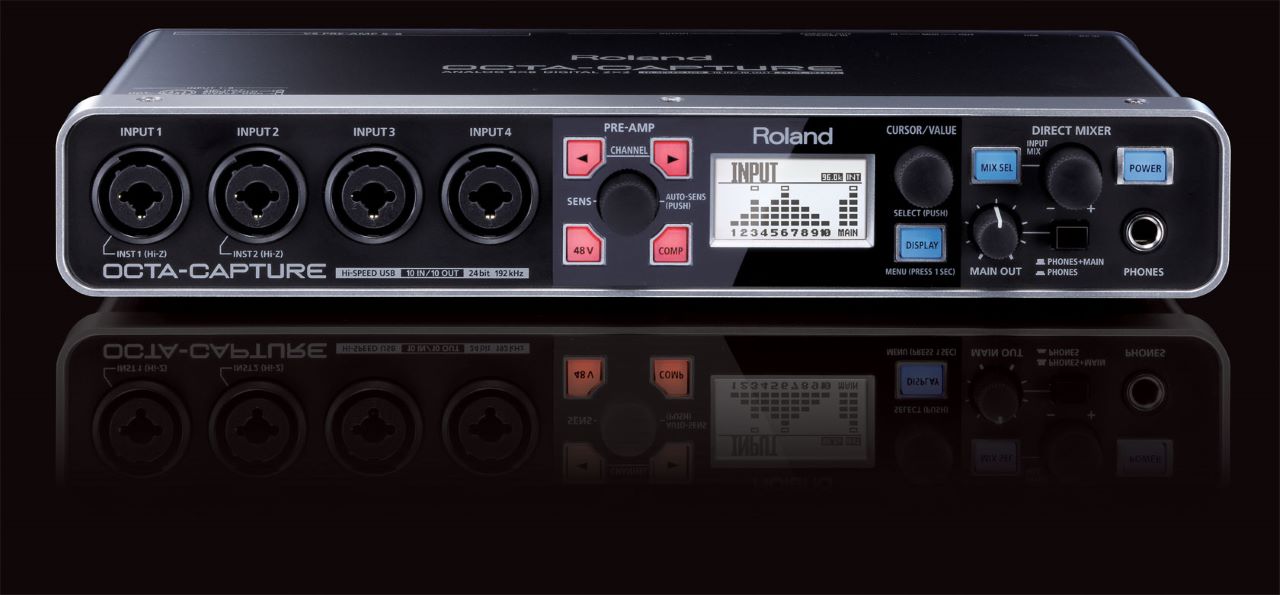
The Roland OCTA-CAPTURE has eight premium mic preamps built in (VS PREAMP). Image Source.
Key Features
- Eight premium-grade digitally controlled mic preamps (VS PREAMPS)
- AUTO-SENS function for intelligent input level adjustment
- Extremely stable low-latency VS STREAMING driver
- Ten inputs and ten outputs for versatile recording setups
- Four independent software-controlled Direct Mixers
- Supports major DAW platforms on Mac and PC, including ASIO 2.0/WDM (Windows) and Core Audio (Mac)
- Rackmount ears are included for easy installation
The Roland OCTA-CAPTURE is a high-speed USB audio interface that promises pristine sound quality combined with a compact I/O design. This interface is a blend of Roland’s top-tier engineering, proprietary preamp, and streaming technology.
With ten inputs and ten outputs, the OCTA-CAPTURE is equipped to handle a variety of recording scenarios, making it an ideal choice for multi-channel computer-based production. It also serves as an excellent solution for expanding the I/O capability of Roland’s V-STUDIO 700 and V-STUDIO 100.
One of the standout features of the OCTA-CAPTURE is its eight premium-grade digitally controlled mic preamps, known as VS PREAMPS. These preamps are built with high-grade components similar to those found in the V-STUDIO 700 and M-400 V-Mixer.
The interface also boasts an AUTO-SENS function, which intelligently sets the optimal input levels for all preamps, ensuring a quick and fail-safe audio capture. The OCTA-CAPTURE’s extreme low-latency driver, known as VS STREAMING, guarantees stability and top-notch USB performance.
This interface also offers four independent software-controlled Direct Mixers, allowing users to craft custom monitor mixes with ease.
Pros
- High-quality preamps for superior audio capture
- AUTO-SENS feature for quick and optimal input level setting
- Versatile I/O suitable for various recording scenarios
- Stable and low-latency performance with VS STREAMING
Cons
- Might be a bit complex for beginners due to its extensive features
- External power supply required
7. Behringer UMC1820

The Behringer UMC1820 has 18×20 USB2.0 Audio/MIDI Interface with ADAT I/O for recording microphones and instruments. Image Source.
Key Features
- Audiophile 18×20, 24-Bit/96 kHz USB Audio/MIDI Interface
- Eight Midas-designed mic preamps for superior sound quality
- AUTO-SENS function for optimal input level setting
- Supports S/PDIF, ADAT, and S/MUX formats
- 8 combination XLR/TRS inputs for versatile connectivity
- MIDI In/Out for connecting control surfaces and other MIDI devices
- Compatible with popular DAWs including Avid Pro Tools, Ableton Live, and Steinberg Cubase
The Behringer UMC1820 is an audiophile-grade USB audio/MIDI interface that promises to bridge the gap between your creative aspirations and your audience. This “studio-in-a-box” is equipped with a USB 2.0 interface, ensuring rapid data transfer and minimal latency. With its 18×20 configuration, the UMC1820 offers a plethora of connectivity options, making it suitable for recording everything from solo instruments to full bands.
One of the standout features of the UMC1820 is its eight Midas-designed mic preamps. These preamps are renowned for their clarity and precision, ensuring that every recording is of the highest quality.
The interface also boasts a 24-Bit/96 kHz conversion rate, ensuring that your recordings are both clear and detailed. The UMC1820 also offers I/O support for various formats, including S/PDIF, ADAT, and S/MUX, making it a versatile choice for various recording scenarios.
The UMC1820 is not just about recording; it’s also about flexibility. With its eight combination XLR/TRS inputs, you can plug in microphones, instruments, or line-level sources, making it a versatile choice for various recording scenarios. Additionally, the interface offers MIDI connectivity, allowing you to communicate with MIDI devices, which adds a layer of control to your recording setup.
Pros
- High-quality Midas-designed preamps for pristine recordings
- Versatile I/O options suitable for various recording scenarios
- AUTO-SENS function for quick and optimal input level setting
- MIDI connectivity for added control
Cons
- External power supply required
- Might be a bit complex for beginners due to its extensive features
8. M-Audio AIR 192|14
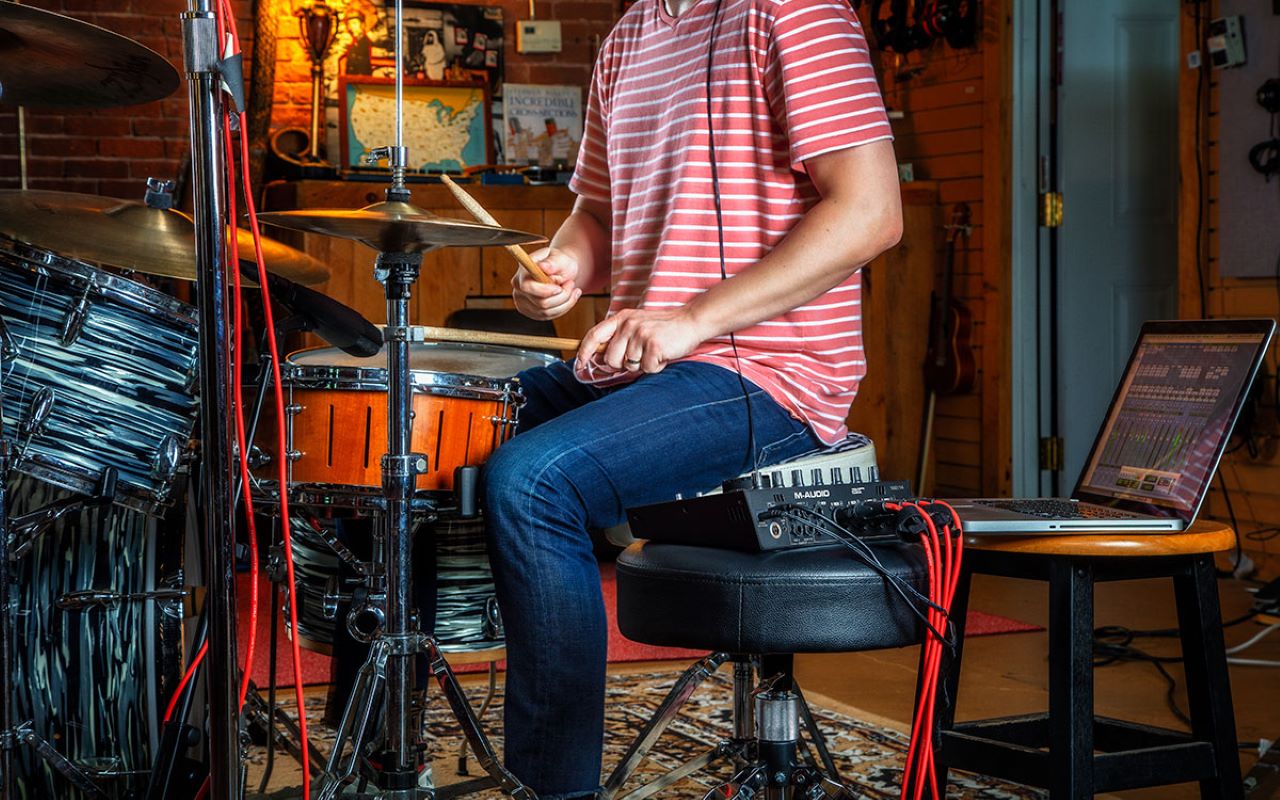
The AIR 192|14 features (4) XLR+¼” TRS combo inputs, (2) ¼” line inputs and (2) ¼” instrument inputs that have a specially designed gain and impedance stage. Image Source.
Key Features
- 8-in 4-out USB audio/MIDI interface
- Features (4) XLR+¼” TRS combo inputs, (2) ¼” line inputs, and (2) ¼” instrument inputs
- 24-bit/192kHz audio quality for studio-grade recordings
- MIDI input and output for connecting external gear
- Comes bundled with Ableton Live Lite, MPC Beats, and a rich collection of effect plugins and virtual instruments
- Zero-latency technology for distraction-free recording
- High-speed USB connection for efficient data transfer
M-Audio’s AIR 192|14 is a robust audio interface designed to cater to the needs of modern producers and musicians. This 8-in-4-out USB audio/MIDI interface promises studio-quality 24-bit/192kHz recordings, ensuring that your creative endeavors are captured with utmost precision. At the heart of the AIR 192|14 are four XLR+¼” TRS combo inputs, two ¼” line inputs, and two ¼” instrument inputs.
These inputs are meticulously designed to provide an accurate representation of your instruments, ensuring that the true essence of your music is captured. Additionally, the interface offers MIDI input and output, making it a versatile choice for those who use external sequencers, drum machines, and controllers.
One of the standout features of the AIR 192|14 is its zero-latency technology. This ensures that you can focus on your performance without being distracted by latency issues. The interface also boasts a high-speed USB connection, ensuring efficient data transfer and seamless recording.
With the inclusion of software like Ableton Live Lite, MPC Beats, and a plethora of effect plugins and virtual instruments, the AIR 192|14 is a comprehensive solution for all your recording needs.
Pros
- Versatile with multiple inputs and outputs
- High-quality audio capture with 24-bit/192kHz resolution
- Comprehensive software bundle for a complete recording solution
- MIDI connectivity for added versatility
Cons
- Might be slightly complex for beginners
- External power supply required
9. TASCAM US-16×08
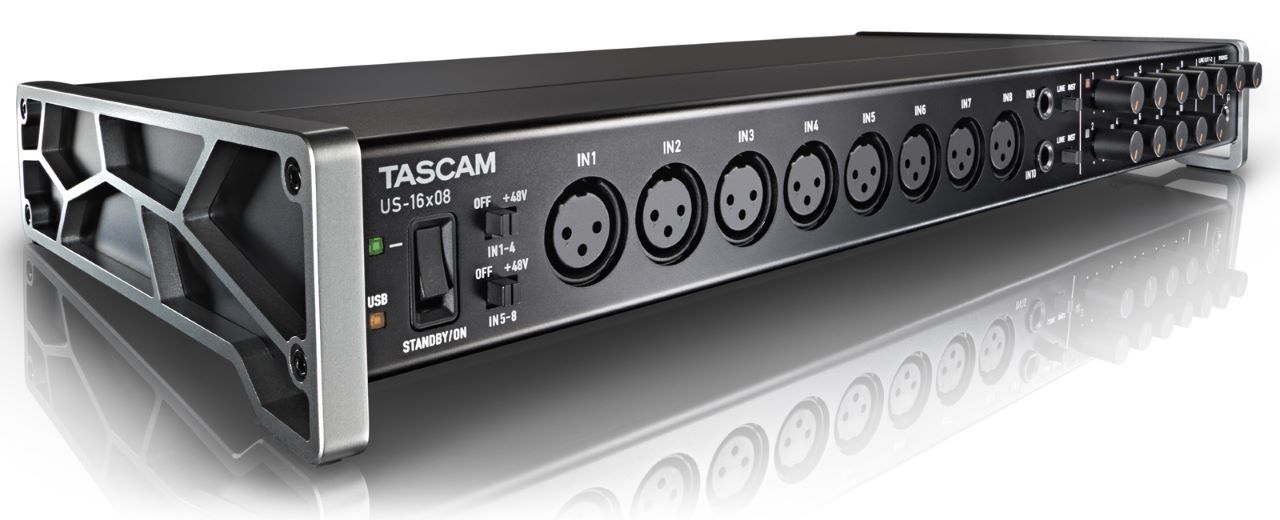
The TASCAM US-16×08 captures 16 mic and line inputs to your computer with clear sound quality and advanced features to manage big sessions. Image Source.
Key Features
- 16-input audio interface for Mac, Windows, and iPad
- 8 Ultra-HDDA microphone preamps with up to 56dB of gain
- DSP Mixer for low-latency electronic mixing with four-band EQ and compaction
- Supports S/PDIF, ADAT, and S/MUX formats
- MIDI input and output for connecting external MIDI devices
- Ergonomically designed angled desktop stand for comfortable operation
- Comes with an all-new driver architecture for enhanced stability
TASCAM’s US-16×08 is a versatile audio interface designed to cater to both budding musicians and seasoned professionals. This 16-input audio interface is engineered to capture clear sound quality, ensuring that your recordings resonate with authenticity.
The US-16×08 is equipped with 8 Ultra-HDDA microphone preamps, which are renowned for their clarity and quiet operation. These preamps, combined with a gain range of up to 56dB, make it ideal for a variety of microphones, be it dynamic, condenser, or ribbon. This ensures that every recording, from vocals to instruments, is captured with precision.
One of the standout features of the US-16×08 is its DSP Mixer, which offers low-latency algorithmic mixing. Each channel is equipped with a four-band compression and EQ, which allows for refined-sounding monitor mixes. The interface also offers a digital patch bay, enabling users to route signals to any output.
The US-16×08 is not just about recording; it’s also about flexibility. With support for both Mac and Windows, as well as USB Class Compliant 2.0 drivers for tablets like Apple’s iPad, the US-16×08 ensures that you can record on any platform of your choice.
Pros
- High-quality preamps ensure pristine audio capture
- Versatile with support for multiple platforms and devices
- Comprehensive DSP Mixer for polished monitor mixes
- Ergonomic design for ease of use and comfort
Cons
- Might be slightly complex for beginners
- External power supply required
10. MOTU 8pre USB
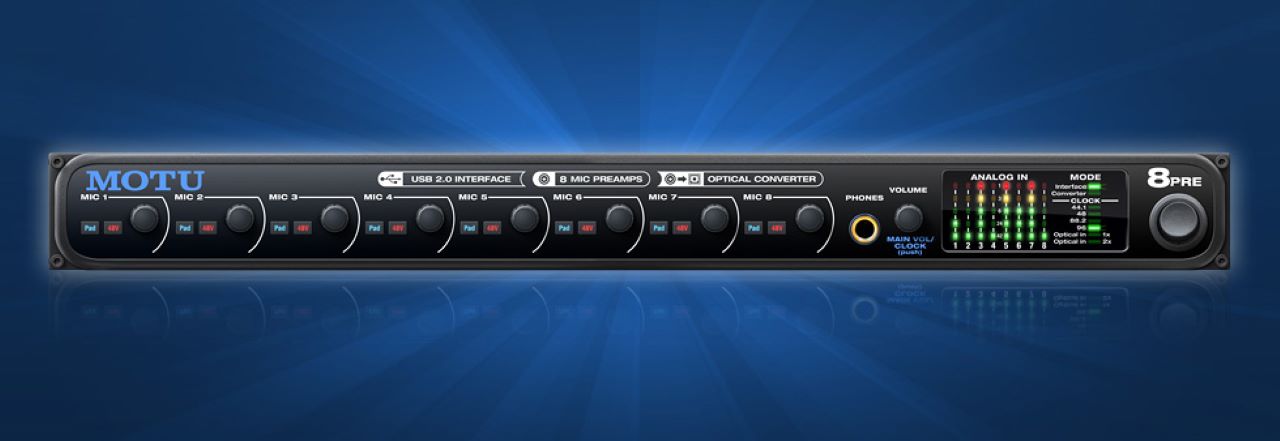
The 8pre provides eight microphone/instrument preamps with pristine 96kHz analog recording and playback, combined with 8 channels of ADAT optical digital I/O. Image Source.
Key Features
- 16-input audio interface for Mac, Windows, and iPad
- Eight microphone/instrument preamps for pristine audio capture
- Supports S/PDIF, ADAT, and S/MUX formats
- MIDI input and output for connecting external MIDI devices
- Ergonomically designed angled desktop stand for comfortable operation
- Comes with an all-new driver architecture for enhanced stability
The MOTU 8pre USB is an audio interface that seamlessly transforms your computer into a full-fledged 24-bit, 96kHz digital audio workstation. This interface is equipped with eight microphone/instrument preamps, ensuring that every recording is captured with the utmost clarity and precision.
The 8pre is not just about recording; it’s also about flexibility. With its 16-input configuration, it can handle a range of instruments, from microphones to guitars, keyboards, and even MIDI devices.
One of the standout features of the 8pre is its DSP Mixer, which offers minimal delay digital mixing. Every channel is equipped with a four-band compression and EQ, allowing for refined-sounding monitor mixes. The interface also offers a digital patchbay, enabling users to route signals to any output.
The 8pre is versatile, supporting both Mac and Windows platforms, as well as USB Class Compliant 2.0 drivers for tablets like Apple’s iPad. This ensures that you can record on any platform of your choice.
Another intriguing aspect of the 8pre is its dual functionality. When not connected to a computer via USB, the 8pre can function as an eight-channel analog-to-digital (optical) converter. This makes it an excellent choice for expanding your current setup, especially if you have a MOTU interface with on-board CueMix DSP mixing.
Pros
- Versatile with support for multiple platforms and devices
- High-quality preamps ensure top-tier audio capture
- Comprehensive DSP Mixer for polished monitor mixes
- Dual functionality as an audio interface and optical converter
Cons
- Might be slightly complex for beginners
- External power supply required
The Evolution Of 8 Channel Audio Interface
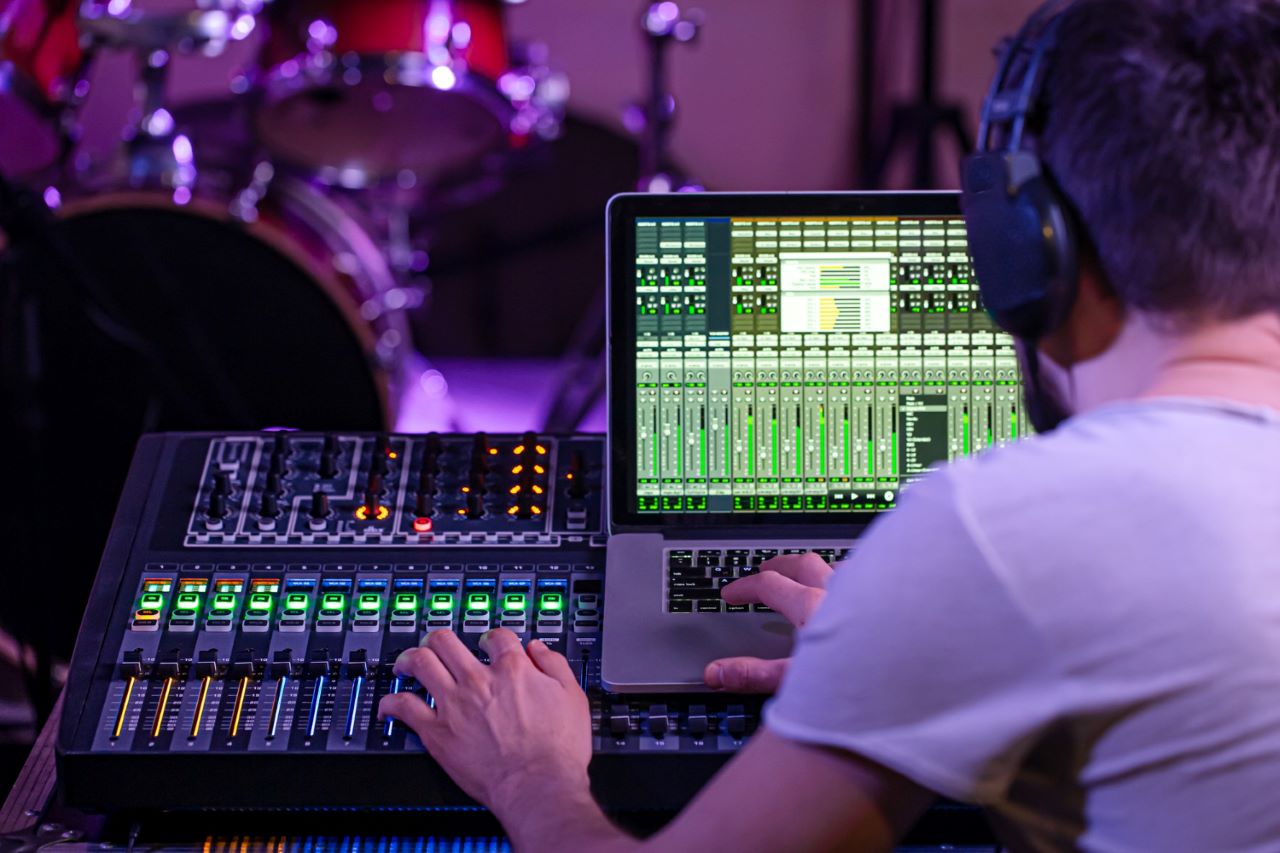
Image by pvproductions on Freepik
In the realm of music production and recording, technology has always been at the forefront, driving innovation and expanding possibilities. The audio interface, a pivotal tool in this domain, has seen significant evolution over the years. Let’s take a brief journey through time to understand how 8-channel audio interfaces have transformed.
In the early days of recording, studios were filled with large mixing consoles, reel-to-reel tape machines, and a plethora of outboard gear. The process was analog, and while it had its charm, it was also cumbersome and expensive. As technology advanced, the need for compact, efficient, and affordable solutions grew. Enter the audio interface with analog inputs.
The first audio interfaces were simple devices, often offering just one or two channels. They served as a bridge between instruments and computers, converting analog signals to digital. As demand grew, so did the capabilities of these interfaces. The 8-channel audio interface emerged as a solution for more complex recording setups, allowing multiple instruments or microphones to be recorded simultaneously with eight combo inputs.
Over the years, 8-channel audio interfaces have become more sophisticated. Modern interfaces boast high-resolution recording capabilities, top-tier preamps, and a range of connectivity options, including XLR inputs. They cater to both the home studio enthusiast and the professional producer, offering flexibility and quality.
Today, an 8-channel audio interface is more than just a tool; it’s a gateway to endless creative possibilities. With advancements in technology, who knows what the future holds? One thing is certain: the evolution of the 8-channel audio interface has revolutionized the way we create music.
Factors To Consider When Choosing An 8 Channel Audio Interface
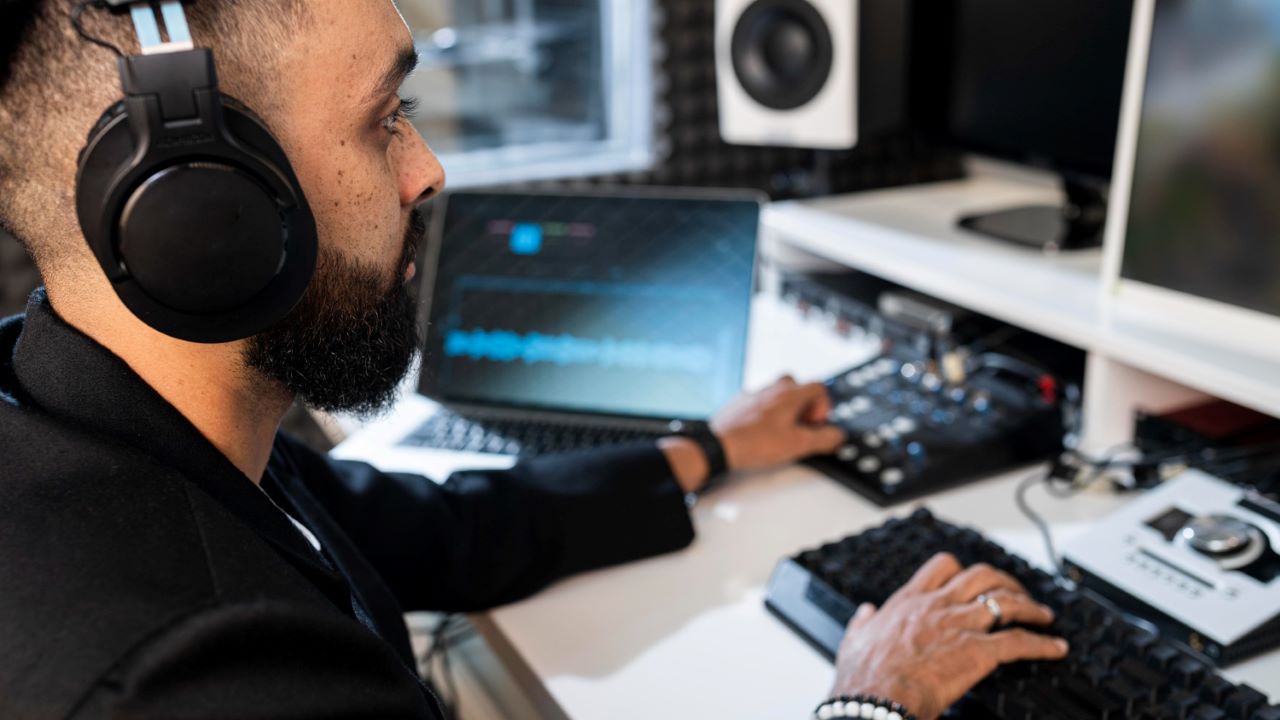
Image by Freepik
When diving into the world of audio recording, one of the most crucial decisions you’ll make is selecting the right audio interface. This device serves as the bridge between your instruments or microphones and your computer, ensuring that your creative endeavors are captured with precision. But with so many options on the market, how do you choose the right one? Here are some factors to consider:
Sound Quality
The primary purpose of an audio interface is to capture sound. Therefore, sound quality should be at the top of your list. Look for interfaces that offer high-resolution recording, typically 24-bit/192kHz. This ensures that your recordings are clear and detailed. Also, consider the quality of the preamps. Brands like Midas, Focusrite, and MOTU are known for their pristine preamps, which can make a significant difference in the clarity of your recordings.
Connectivity Options
Different interfaces offer various connectivity options. Some might have USB, while others offer FireWire, Thunderbolt, or even USB-C. Your choice should depend on the ports available on your computer and your preference for data transfer speeds. For instance, Thunderbolt is known for its rapid data transfer rates, making it ideal for professionals.
Expandability
Your recording needs might grow over time. Perhaps you start with a solo project but eventually decide to record a full band. In such cases, having an interface that can expand its input channel can be invaluable. Look for interfaces that offer ADAT or S/PDIF connectivity, allowing you to add more channels as needed.
Software Compatibility
Most audio interfaces come bundled with recording software. However, if you have a preferred Digital Audio Workstation (DAW), ensure that the interface is compatible with it. Also, consider the plugins and virtual instruments that come with the interface, as these can enhance your recording and production capabilities.
Budget
While it’s essential to invest in a quality audio interface, it’s equally important to stay within your budget. Thankfully, the market offers options for every price range. Remember, the most expensive interface isn’t necessarily the best for your needs. Assess your requirements and find a balance between quality and cost.
FAQs
Why Would I Need An 8-Channel Audio Interface Over a 2-Channel One?
An 8-channel audio interface offers more inputs and outputs than a 2-channel one. This is particularly beneficial if you’re recording multiple instruments simultaneously, such as a drum kit, a band, or an ensemble.
With independent volume control, you can capture each instrument on a separate track, giving you more control during the mixing process. On the other hand, a 2-channel interface is more suited for solo artists or podcasters who only need to record one or two sources at a time.
Are Higher Sample Rates Like 192kHz Always Better For Recording?
While higher sample rates like 192kHz can capture more audio detail, they aren’t always necessary for every recording scenario. Recording at such high sample rates can consume more storage space and demand more from your computer’s CPU.
For most applications, 44.1kHz or 48kHz (standard for CDs and video, respectively) are sufficient. However, if you’re working on a project that requires extreme detail or you plan to manipulate the recording heavily in post-production, higher sample rates can be beneficial.
Can I Use My 8-Channel Audio Interface For Live Performances?
Absolutely! Many 8-channel audio interfaces are versatile enough to be used both in the studio and on stage. They can serve as a mixer, allowing you to control the sound of multiple instruments. Some interfaces also come with DSP effects that can be applied in real time during live performances. Always check the features and capabilities of the interface to ensure it meets your live sound needs.
How Important Are The Preamps In An Audio Interface?
Preamps play a crucial role in determining the sound quality of your recordings. They amplify the weak signals from microphones to a level suitable for recording. High-quality preamps ensure that this amplification is clean, transparent, and free from unwanted noise or coloration. Investing in an audio interface with top-tier preamps can significantly elevate the quality of your recordings.
Do All 8-Channel Audio Interface Come With Bundled Recording Software?
Most modern 8-channel audio interfaces come bundled with some form of recording software or Digital Audio Workstation (DAW). This can range from lite versions of popular DAWs like Ableton Live or Pro Tools to full-fledged software suites. It’s always a good idea to check what software is included with the interface, as this can add significant value to your purchase and get you started with recording right away.
Related: Best Audio Interface Under 200 Dollars
Conclusion
Choosing the right 8-channel audio interface is a journey that requires careful consideration of your needs, budget, and long-term goals. Whether you’re a budding musician, a seasoned producer, or somewhere in between, the perfect interface for you is out there.
By considering sound quality, connectivity options, expandability, software compatibility, and budget, you can find an interface that not only meets but exceeds your expectations. Remember, the right tools can elevate your music, bringing your creative vision to life in the most authentic way possible.
And with features like phantom power, headphone output, and USB audio interfaces, you’re sure to find the perfect fit for your recording needs.
